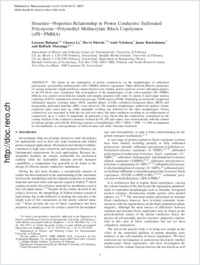Structure−properties relationship in proton conductive sulfonated polystyrene−polymethyl methacrylate block copolymers (sPS−PMMA)
- Rubatat, Laurent Department of Physics and Fribourg Center for Nanomaterials, University of Fribourg, Fribourg, Switzerland - EPCP, Université de Pau, Technopole Helioparc, Pau, France
- Li, Chaoxu Department of Physics and Fribourg Center for Nanomaterials, University of Fribourg, Fribourg, Switzerland
- Dietsch, Hervé Department of Physics and Fribourg Center for Nanomaterials, University of Fribourg, Fribourg, Switzerland - Adolphe Merkle Institute, University of Fribourg, Switzerland
- Nykänen, Antti Department of Engineering Physics, Helsinki University of Technology, Finland
- Ruokolainen, Janne Department of Engineering Physics, Helsinki University of Technology, Finland
- Mezzenga, Raffaele Nestlé Research Center, Lausanne, Switzerland - Department of Physics and Fribourg Center for Nanomaterials, University of Fribourg, Fribourg, Switzerland
-
16.10.2008
Published in:
- Macromolecules. - 2009, vol. 41, no. 21, p. 8130–8137
English
We report on the dependence of proton conductivity on the morphologies of sulfonated polystyrene−poly(methyl methacrylate) (sPS−PMMA) diblock copolymers. Three different diblock copolymers of varying molecular weight and block volume fraction were studied, and for each one several sulfonation degrees of the PS block were considered. The investigation of the morphologies of the self-assembled sPS−PMMA diblocks was carried out in both dry samples and samples saturated with water, by means of small angle neutron scattering (SANS), transmission electron microscopy (TEM) and cryoTEM. Depending on molecular weight and sulfonation degrees, isotropic phase (ISO), lamellar phases (LAM), cylindrical hexagonal phase (HEX) and hexagonally perforated lamellae (HPL) were observed. The lamellar morphologies underwent marked volume expansion upon water pick up, while negligible swelling was detected for the other morphologies. Proton conductivity was measured in both the dry and wet states, the latter conditions resulting in an enhancement of conductivity up to 3 orders of magnitude. In particular it was shown that the conductivity, normalized by the volume fraction of the conductive domains (formed by PS, sPS and water), rises monotonically with the content of sulfonic groups, and with the following sequence of morphologies: ISO → HEX → HPL → LAM, accompanied by discontinuities in correspondence of order-to-order and order−disorder transitions.
- Faculty
- Faculté des sciences et de médecine
- Department
- Département de Physique
- Language
-
- English
- Classification
- Physics
- License
- License undefined
- Identifiers
-
- RERO DOC 11752
- DOI 10.1021/ma801543q
- Persistent URL
- https://folia.unifr.ch/unifr/documents/301149
Statistics
Document views: 79
File downloads:
- mezzenga_spr.pdf: 220
